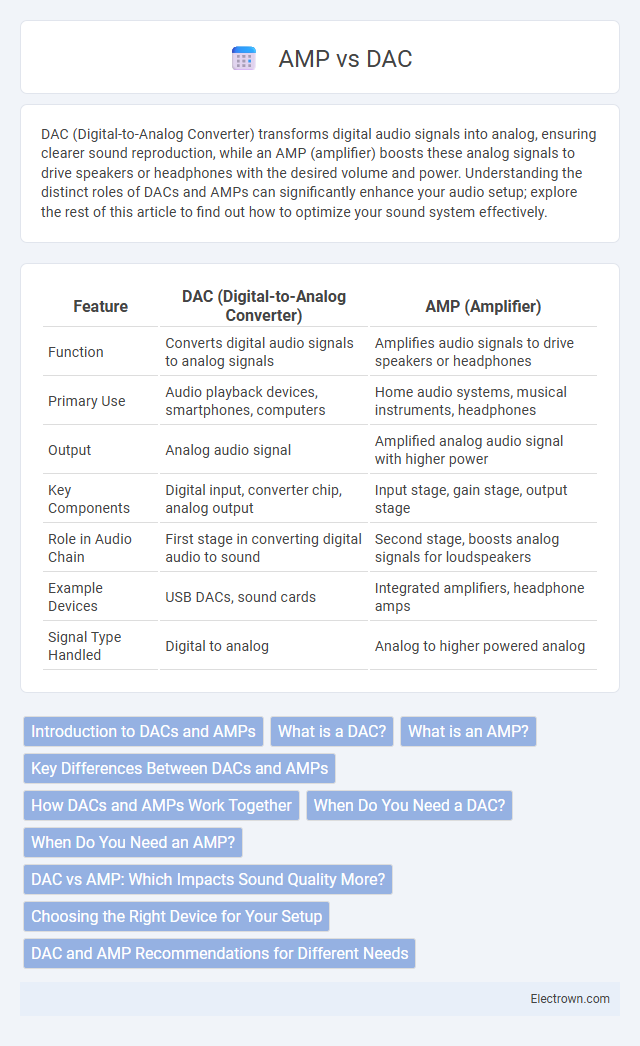DAC (Digital-to-Analog Converter) transforms digital audio signals into analog, ensuring clearer sound reproduction, while an AMP (amplifier) boosts these analog signals to drive speakers or headphones with the desired volume and power. Understanding the distinct roles of DACs and AMPs can significantly enhance your audio setup; explore the rest of this article to find out how to optimize your sound system effectively.
Table of Comparison
| Feature | DAC (Digital-to-Analog Converter) | AMP (Amplifier) |
|---|---|---|
| Function | Converts digital audio signals to analog signals | Amplifies audio signals to drive speakers or headphones |
| Primary Use | Audio playback devices, smartphones, computers | Home audio systems, musical instruments, headphones |
| Output | Analog audio signal | Amplified analog audio signal with higher power |
| Key Components | Digital input, converter chip, analog output | Input stage, gain stage, output stage |
| Role in Audio Chain | First stage in converting digital audio to sound | Second stage, boosts analog signals for loudspeakers |
| Example Devices | USB DACs, sound cards | Integrated amplifiers, headphone amps |
| Signal Type Handled | Digital to analog | Analog to higher powered analog |
Introduction to DACs and AMPs
DACs (Digital-to-Analog Converters) transform digital audio signals into analog signals, enabling high-quality sound playback from devices like computers and smartphones. AMPs (Amplifiers) increase the power of these analog signals to drive speakers or headphones, ensuring clear and audible sound output. Understanding the role of your DAC and AMP can significantly improve your audio experience by optimizing signal quality and volume.
What is a DAC?
A DAC (Digital-to-Analog Converter) transforms digital audio signals into analog sound waves that can be heard through speakers or headphones. It plays a crucial role in connecting digital devices like smartphones, computers, or streaming devices to analog audio equipment, ensuring high-quality sound reproduction. Your music experience relies on a DAC to convert encoded data into clear, detailed audio.
What is an AMP?
An AMP, or amplifier, boosts the audio signal's power to drive headphones or speakers effectively, enhancing sound volume and clarity. It takes the low-level output from a Digital-to-Analog Converter (DAC) or audio source and increases it to deliver sufficient power for high-quality listening experiences. Your audio setup benefits from a dedicated AMP by minimizing distortion and improving overall sound dynamics.
Key Differences Between DACs and AMPs
DACs (Digital-to-Analog Converters) convert digital audio signals into analog signals that can be processed by audio equipment, while AMPs (Amplifiers) increase the power of these analog signals to drive speakers or headphones. DACs are essential for improving audio clarity and detail by reducing digital noise and distortion, whereas AMPs primarily enhance volume and sound dynamics. The synergy between high-quality DACs and AMPs defines the overall sound fidelity in audio systems.
How DACs and AMPs Work Together
DACs convert digital audio signals into analog signals that amplifiers process to drive speakers or headphones, ensuring accurate sound reproduction. Amplifiers boost the low-level analog signals from DACs to a level suitable for output devices, maintaining audio fidelity and power. Your audio system relies on the seamless interaction between DACs and AMPs to deliver clear, high-quality sound.
When Do You Need a DAC?
You need a DAC when your audio source outputs digital signals that require conversion to analog for playback on headphones or speakers. DACs improve sound clarity and detail by translating digital audio files into analog signals with minimal distortion. If your device lacks a high-quality built-in DAC or you use high-resolution audio formats, an external DAC can significantly enhance your listening experience.
When Do You Need an AMP?
An amplifier (AMP) is necessary when your audio source or headphones require additional power to reach optimal listening volume and sound quality. Low-impedance headphones, typically below 50 ohms, usually perform well without an AMP, while high-impedance headphones above 100 ohms benefit significantly from amplification. Using an AMP ensures cleaner sound reproduction, increased volume, and reduced distortion, especially in professional audio setups or high-end consumer audio systems.
DAC vs AMP: Which Impacts Sound Quality More?
The Digital-to-Analog Converter (DAC) often impacts sound quality more significantly than the Amplifier (AMP) because it processes the digital audio signal into an analog format, directly influencing clarity and detail. While an AMP boosts the audio signal's power for driving speakers or headphones, the quality of conversion by the DAC fundamentally shapes how accurately the sound is reproduced. When choosing audio equipment, prioritizing a high-quality DAC can greatly enhance your listening experience by reducing digital distortion and preserving audio fidelity.
Choosing the Right Device for Your Setup
Selecting the right device between a DAC (Digital-to-Analog Converter) and an AMP (Amplifier) depends on your existing audio equipment and listening preferences. DACs improve audio quality by converting digital signals to analog, essential for setups with poor internal converters, while AMPs boost the analog signal to drive speakers or headphones effectively, crucial for low-impedance headphones or passive speakers. Assess your current gear's needs to determine if enhancing digital clarity with a DAC or increasing power with an AMP will best optimize your sound system.
DAC and AMP Recommendations for Different Needs
For music enthusiasts seeking high-fidelity sound, pairing a high-quality DAC like the AudioQuest DragonFly with a powerful headphone amplifier such as the Schiit Magni ensures clear, detailed audio reproduction. Gamers looking to enhance spatial awareness should consider an AMP/DAC combo with low latency and surround sound support, such as the SteelSeries Sonar or Creative Sound BlasterX G6. Your choice depends on specific use cases: prioritize standalone DACs for improving digital-to-analog conversion clarity or amplifiers for driving higher impedance headphones with adequate power and minimal distortion.
DAC vs AMP Infographic

 electrown.com
electrown.com